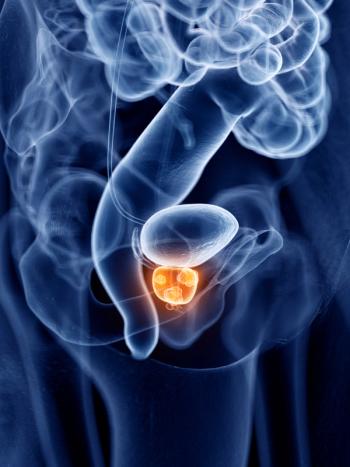
Oncology NEWS International
- Oncology NEWS International Vol 11 No 5
- Volume 11
- Issue 5
FK506 May Prevent Impotence After Nerve-Sparing Surgery
BALTIMORE-A single injection of FK506 (Prograf) or a similar immunophilin drug at the time of surgery might prevent impotence in men undergoing nerve-sparing prostatectomy for localized prostate cancer, according to preclinical work reported in Nature Medicine (7:1073-1074, 2001) by Sena F. Sezen, PhD, and colleagues at the Johns Hopkins Medical Institutions.
BALTIMOREA single injection of FK506 (Prograf) or a similar immunophilin drug at the time of surgery might prevent impotence in men undergoing nerve-sparing prostatectomy for localized prostate cancer, according to preclinical work reported in Nature Medicine (7:1073-1074, 2001) by Sena F. Sezen, PhD, and colleagues at the Johns Hopkins Medical Institutions.
The researchers found that a 1 mg/kg intraperitoneal dose of FK506 preserved 90% of erectile function and reduced nerve damage by about half in rats subjected to nerve damage similar to that seen with nerve-sparing radical prostatectomy.
This study has clinical implications for the 80,000 men each year who must face treatment for localized prostate cancer. Nerve-sparing prostatectomy techniques had been thought to reduce the incidence of impotence to about 30%, but the Prostate Cancer Outcomes study, a population-based longitudinal cohort study, found that 56% of men who were potent before bilateral nerve-sparing prostatectomy reported being unable to achieve intercourse at 18 or more months after surgery (JAMA 283:354-360, 2000).
Fujisawa Healthcare, which markets FK506 as an immunosuppressant for prevention of allograft rejection, has no plans for testing the drug as a neuroprotectant during prostatectomy. However, senior author Solomon H. Snyder, MD, told ONI that Guilford Pharmaceuticals will begin trials with NIL-A, a derivative of FK506 that retains the parent compound’s neurotrophic and neuroprotective effects but does not suppress immune function. NIL-A is currently in development for the treatment of Parkinson’s disease.
Dr. Snyder is professor and director of the Department of Neuroscience at the Johns Hopkins School of Medicine. He is also co-founder and chief scientific advisor of Guilford Pharmaceuticals.
In addition to Drs. Snyder and Sezen, the research team included Ahmet Hoke, MD, PhD, and Arthur L. Burnett, MD. Dr. Hoke is assistant professor and co-director of the Neuromuscular Pathology Laboratory at Johns Hopkins. Dr. Burnett is in the Department of Urology.
Study Protocol
The investigators subjected rats to 15-second forceps partial crush injury of the cavernous nerve on one side and sham surgery on the other side. Daily treatment with FK506 (1 mg/kg IP) or saline began at the time of nerve injury and continued for up to 7 days.
On days 1, 3, and 7, the investigators measured erectile responses (intracavernosal pressure changes in response to cavernous nerve electrical stimulation) and evaluated changes in cavernous nerve morphology.
Erectile response decreased by 50% (compared to the sham-operated side) in saline-treated rats, but remained at 90% in animals treated with FK506. This difference was statistically significant as early as 1 day following surgery (P = .003) and was maintained through day 7.
The erectile response was apparently preserved because FK506 protected the penile nerves from degeneration following injury. FK506-treated rats had significantly more surviving unmyelinated axons at all three time points, compared with saline-treated rats (
P
< .005).
Axonal survival increased from 30% to 40% in the saline-treated rats to 80% at day 1, 70% at day 3, and 65% at day 7 in the FK506-treated animals.
Dr. Hoke, who did the neuropathology, told ONI that he was surprised at the amount of protection FK506 provided. "The effects of this drug have been modest in other peripheral nerve injury models, such as those involving the sciatic nerve. The difference may be due to the partial nerve damage in the prostatectomy model rats," he said.
Underlying Mechanism Unknown
The mechanism underlying the effect is unknown, but Dr. Snyder said that since it was apparent as early as 1 day after surgery and treatment, it likely involves neuroprotection rather than the neuroregenerative activity previously observed with FK506.
"We think that this treatment makes the nerve fibers more resistant to insult from stretching or other causes," Dr. Hoke said. "After nerve-sparing prostatectomy, much of the damage is due to stretching of the nerve fibers, which continue to appear grossly normal but have internal pathological and functional changes." Similar effects had been reported for FK506 in protection of retinal ganglion cells after optic nerve crush and of spinal dorsal column axons after partial spinal cord transection, as well as in animal models of stroke.
"The exciting possibility from our study is that it suggests a practical use for neuroprotective immunophilin drugs," Dr. Snyder said. "There have been numerous failed attempts to transfer neuroprotective agents from research to clinical use. In stroke, this has been because the drugs must be given within a few hours of symptom onsetseldom possible in the real world. But prostatectomy produces an iatrogenic nerve injury that occurs at a known time and in a setting where treating with a neuroprotectant before cutting could be easily incorporated into standard practice."
Articles in this issue
over 23 years ago
Prognosis Good for Local Recurrence After Lumpectomyover 23 years ago
Long-Term Use of Actiq Safe and Effective for Breakthrough Painover 23 years ago
Youth Exposed to Tobacco Promotionsover 23 years ago
Green Tea May Help Prevent Certain Gastrointestinal Cancersover 23 years ago
EGFR Inhibitor Effective as Salvage Therapy for NSCLCover 23 years ago
Targeted Filgrastim Support Allows Planned Chemotherapy Dosesover 23 years ago
Low Risk of CHF With Paclitaxel/Trastuzumab Adjuvant Rxover 23 years ago
Anxiety, Depression in Women at High Risk for Breast Cancerover 23 years ago
NCCN Updates its Treatment Guidelines for Breast Cancerover 23 years ago
Danny Glover ‘Acting’ as Spokesman for Anemia LifeLineNewsletter
Stay up to date on recent advances in the multidisciplinary approach to cancer.



















































































